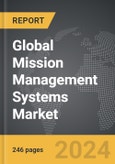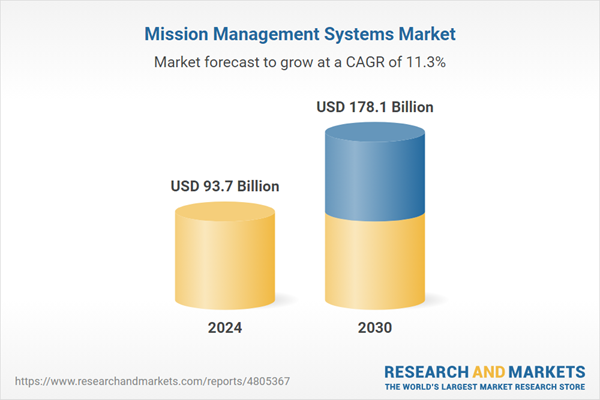Global Mission Management Systems Market - Key Trends & Drivers Summarized
What Are Mission Management Systems and Why Are They Crucial for Defense Operations?
Mission management systems are essential tools that integrate various functions within military operations, including planning, training, simulation, and execution. These systems provide comprehensive solutions that enhance situational awareness and operational coordination. They are used across multiple platforms, such as aircraft, ships, and ground vehicles, enabling forces to perform coordinated and efficient missions. The ability of these systems to integrate real-time data from different sources and provide actionable intelligence is crucial for mission success, making them indispensable in modern military operations.How Is Integration Shaping the Future of Mission Management Systems?
The integration of advanced technologies such as artificial intelligence, machine learning, and real-time data analytics into mission management systems is transforming the way military operations are conducted. These technologies enhance the systems' capabilities in data processing and decision-making, providing military personnel with superior tools for mission analysis and strategy formulation. The ability to seamlessly integrate with existing and new platforms ensures that these systems can adapt to evolving operational needs, making them highly valuable for future missions.What Role Does Interoperability Play in Mission Management Systems?
Interoperability is a critical aspect of mission management systems, particularly in joint operations involving multiple countries and services. These systems are designed to operate across different platforms and environments, ensuring that all units involved in a mission can communicate and coordinate effectively. The standardization of communication protocols and data formats is key to achieving interoperability, which enhances the overall effectiveness and agility of military operations.Which Key Factors Propel the Expansion of the Mission Management Systems Market?
The growth in the mission management systems market is driven by several factors, including the increasing complexity of military operations and the need for enhanced interoperability and coordination among various defense units. The integration of new technologies such as AI and real-time analytics into these systems is also a significant growth driver, enhancing their capabilities and efficiency. Furthermore, the rising global security threats necessitate continuous advancements in military technology, promoting investments in mission management systems. The need for streamlined operations in defense strategies ensures that these systems remain in demand, contributing to the robust growth of the market.Report Scope
The report analyzes the Mission Management Systems market, presented in terms of units. The analysis covers the key segments and geographic regions outlined below.Segments: Application (Air-Based, Naval-Based, Land-Based, Unmanned Systems-Based); End-Use (Defense, Commercial).
Geographic Regions/Countries: World; United States; Canada; Japan; China; Europe (France; Germany; Italy; United Kingdom; and Rest of Europe); Asia-Pacific; Rest of World.
Key Insights:
- Market Growth: Understand the significant growth trajectory of the Air-Based segment, which is expected to reach US$34.6 Billion by 2030 with a CAGR of a 11.9%. The Naval-Based segment is also set to grow at 10.3% CAGR over the analysis period.
- Regional Analysis: Gain insights into the U.S. market, valued at $25.8 Billion in 2024, and China, forecasted to grow at an impressive 10.6% CAGR to reach $27.4 Billion by 2030. Discover growth trends in other key regions, including Japan, Canada, Germany, and the Asia-Pacific.
Why You Should Buy This Report:
- Detailed Market Analysis: Access a thorough analysis of the Global Mission Management Systems Market, covering all major geographic regions and market segments.
- Competitive Insights: Get an overview of the competitive landscape, including the market presence of major players across different geographies.
- Future Trends and Drivers: Understand the key trends and drivers shaping the future of the Global Mission Management Systems Market.
- Actionable Insights: Benefit from actionable insights that can help you identify new revenue opportunities and make strategic business decisions.
Key Questions Answered:
- How is the Global Mission Management Systems Market expected to evolve by 2030?
- What are the main drivers and restraints affecting the market?
- Which market segments will grow the most over the forecast period?
- How will market shares for different regions and segments change by 2030?
- Who are the leading players in the market, and what are their prospects?
Report Features:
- Comprehensive Market Data: Independent analysis of annual sales and market forecasts in US$ Million from 2024 to 2030.
- In-Depth Regional Analysis: Detailed insights into key markets, including the U.S., China, Japan, Canada, Europe, Asia-Pacific, Latin America, Middle East, and Africa.
- Company Profiles: Coverage of players such as Aerocomputers, Inc., Bird Aerosystem Ltd., Curtiss-Wright Corporation, Honeywell International, Inc., Lockheed Martin Corporation and more.
- Complimentary Updates: Receive free report updates for one year to keep you informed of the latest market developments.
Some of the 46 companies featured in this Mission Management Systems market report include:
- Aerocomputers, Inc.
- Bird Aerosystem Ltd.
- Curtiss-Wright Corporation
- Honeywell International, Inc.
- Lockheed Martin Corporation
- Neya Systems, LLC.
- Northrop Grumman Corporation
- Piaggio Aero Industries S.P.A
- Quinetiq Group PLC.
- SAAB AB
- Thales Group
Tariff Impact Analysis: Key Insights for 2025
Global tariff negotiations across 180+ countries are reshaping supply chains, costs, and competitiveness. This report reflects the latest developments as of April 2025 and incorporates forward-looking insights into the market outlook.The analysts continuously track trade developments worldwide, drawing insights from leading global economists and over 200 industry and policy institutions, including think tanks, trade organizations, and national economic advisory bodies. This intelligence is integrated into forecasting models to provide timely, data-driven analysis of emerging risks and opportunities.
What’s Included in This Edition:
- Tariff-adjusted market forecasts by region and segment
- Analysis of cost and supply chain implications by sourcing and trade exposure
- Strategic insights into geographic shifts
Buyers receive a free July 2025 update with:
- Finalized tariff impacts and new trade agreement effects
- Updated projections reflecting global sourcing and cost shifts
- Expanded country-specific coverage across the industry
Table of Contents
Companies Mentioned (Partial List)
A selection of companies mentioned in this report includes, but is not limited to:
- Aerocomputers, Inc.
- Bird Aerosystem Ltd.
- Curtiss-Wright Corporation
- Honeywell International, Inc.
- Lockheed Martin Corporation
- Neya Systems, LLC.
- Northrop Grumman Corporation
- Piaggio Aero Industries S.P.A
- Quinetiq Group PLC.
- SAAB AB
- Thales Group
Table Information
| Report Attribute | Details |
|---|---|
| No. of Pages | 246 |
| Published | April 2025 |
| Forecast Period | 2024 - 2030 |
| Estimated Market Value ( USD | $ 93.7 Billion |
| Forecasted Market Value ( USD | $ 178.1 Billion |
| Compound Annual Growth Rate | 11.3% |
| Regions Covered | Global |









